Spatial Mapping of a Highly Non-Uniform Distribution of Particle-Bound PAH in a Densely Populated Urban Area
Abstract
1. Introduction
2. Methods
2.1. Mapping Protocol
2.2. Mobile Monitoring
3. Results and Discussion
3.1. Zone- and Cell-Based Analysis
3.2. Spatial Distribution in the Air Pollution Map
4. Conclusions
Author Contributions
Funding
Conflicts of Interest
References
- Hitchins, J.; Morawska, L.; Wolff, R.; Gilbert, D. Concentrations of submicrometre particles from vehicle emissions near a major road. Atmos. Environ. 2000, 34, 51–59. Available online: http://www.sciencedirect.com/science/article/pii/S1352231099003040 (accessed on 27 October 1999). [CrossRef]
- Touma, J.S.; Isakov, V.; Ching, J.; Seigneur, C. Air quality modeling of hazardous pollutants: Current status and future directions. J. Air Waste Manag. Assoc. 2006, 56, 547–558. [Google Scholar] [CrossRef] [PubMed]
- Joint, W.H.O.; World Health Organization. Health Risks of Particulate Matter from Long-Range Transboundary Air Pollution; WHO Regional Office for Europe: Copenhagen, Denmark, 2006. [Google Scholar]
- IARC. Iarc: Diesel Engine Exhaust Carcinogenic. 2012. Available online: https://www.iarc.fr/en/media-centre/pr/2012/pdfs/pr213_E.pdf (accessed on 12 June 2012).
- Kim, K.H.; Lee, S.B.; Woo, D.; Bae, G.N. Influence of wind direction and speed on the transport of particle-bound PAHs in a roadway environment. Atmos. Pollut. Res. 2016, 6, 1024–1034. Available online: http://www.sciencedirect.com/science/article/pii/S1309104215000148 (accessed on 21 October 2015). [CrossRef]
- Kim, K.H.; Woo, D.; Lee, S.B.; Bae, G.N. On-road measurements of ultrafine particles and associated air pollutants in a densely populated area of Seoul, Korea. Aerosol Air Q. Res. 2015, 15, 142–153. [Google Scholar] [CrossRef]
- Houston, D.; Wu, J.; Yang, D.; Jaimes, G. Particle-bound polycyclic aromatic hydrocarbon concentrations in transportation microenvironments. Atmos. Environ. 2013, 71, 148–157. Available online: http://www.sciencedirect.com/science/article/pii/S135223101300099X (accessed on 13 February 2013). [CrossRef]
- Lee, J.Y.; Lee, S.-B.; Bae, G.-N. A review of the association between air pollutant exposure and allergic diseases in children. Air Pollut. Res. 2014, 5, 616–629. [Google Scholar] [CrossRef]
- Zanobetti, A.; Luttmann-Gibson, H.; Horton, E.S.; Cohen, A.; Coull, B.A.; Hoffmann, B.; Schwartz, J.D.; Mittleman, M.A.; Li, Y.; Stone, P.H.; et al. Brachial artery responses to ambient pollution, temperature, and humidity in people with type 2 diabetes: A repeated-measures study. Environ. Health Perspect. 2014, 122, 242–248. [Google Scholar] [CrossRef]
- Guo, Y.L.; Lin, Y.C.; Sung, F.C.; Huang, S.L.; Ko, Y.C.; Lai, J.S.; Su, H.J.; Shaw, C.K.; Lin, R.S.; Dockery, D.W. Climate, traffic-related air pollutants, and asthma prevalence in middle-school children in Taiwan. Environ. Health Perspect. 1999, 107, 1001–1006. Available online: http://www.ncbi.nlm.nih.gov/pmc/articles/PMC1566819/ (accessed on 17 November 1999). [CrossRef]
- Venn, A.; Lewis, S.; Cooper, M.; Hubbard, R.; Britton, J. Living near a main road and the risk of wheezing illness in children. Am. J. Respir. Crit. Care Med. 2001, 164, 2177–2180. [Google Scholar] [CrossRef]
- Lee, Y.L.; Su, H.J.; Sheu, H.M.; Yu, H.S.; Guo, Y.L. Traffic-related air pollution, climate, and prevalence of eczema in Taiwanese school children. J. Invest. Dermatol. 2008, 128, 2412–2420. [Google Scholar] [CrossRef]
- Jerrett, M.; Shankardass, K.; Berhane, K.; Gauderman, W.J.; Kunzli, N.; Avol, E.; Gilliland, F.; Lurmann, F.; Molitor, J.N.; Molitor, J.T.; et al. Traffic-related air pollution and asthma onset in children: A prospective cohort study with individual exposure measurement. Environ. Health Perspect. 2008, 116, 1433–1438. [Google Scholar] [CrossRef] [PubMed]
- Cook, A.G.; de Vos, A.J.; Pereira, G.; Jardine, A.; Weinstein, P. Use of a total traffic count metric to investigate the impact of roadways on asthma severity: A case-control study. Environ. Health 2011, 10, 52. [Google Scholar] [CrossRef] [PubMed]
- Morgenstern, V.; Zutavern, A.; Cyrys, J.; Brockow, I.; Koletzko, S.; Kramer, U.; Behrendt, H.; Herbarth, O.; von Berg, A.; Bauer, C.P.; et al. Atopic diseases, allergic sensitization, and exposure to traffic-related air pollution in children. Am. J. Respir. Crit. Care Med. 2008, 177, 1331–1337. [Google Scholar] [CrossRef] [PubMed]
- Stein, A.F.; Isakov, V.; Godowitch, J.; Draxler, R.R. A hybrid modeling approach to resolve pollutant concentrations in an urban area. Atmos. Environ. 2007, 41, 9410–9426. Available online: http://www.sciencedirect.com/science/article/pii/S1352231007007881 (accessed on 14 September 2007). [CrossRef]
- Isakov, V.; Touma, J.S.; Burke, J.; Lobdell, D.T.; Palma, T.; Rosenbaum, A.; Ozkaynak, H. Combining regional- and local-scale air quality models with exposure models for use in environmental health studies. J. Air Waste Manag. Assoc. 2009, 59, 461–472. [Google Scholar] [CrossRef]
- Van den Bossche, J.; Peters, J.; Verwaeren, J.; Botteldooren, D.; Theunis, J.; de Baets, B. Mobile monitoring for mapping spatial variation in urban air quality: Development and validation of a methodology based on an extensive dataset. Atmos. Environ. 2015, 105, 148–161. Available online: http://www.sciencedirect.com/science/article/pii/S1352231015000254 (accessed on 8 January 2015). [CrossRef]
- Westerdahl, D.; Fruin, S.; Sax, T.; Fine, P.M.; Sioutas, C. Mobile platform measurements of ultrafine particles and associated pollutant concentrations on freeways and residential streets in Los Angeles. Atmos. Environ. 2005, 39, 3597–3610. [Google Scholar] [CrossRef]
- Hagler, G.S.; Thoma, E.D.; Baldauf, R.W. High-resolution mobile monitoring of carbon monoxide and ultrafine particle concentrations in a near-road environment. J. Air Waste Manag. Assoc. 2010, 60, 328–336. [Google Scholar] [CrossRef]
- Kim, K.H.; Lee, S.-B.; Woo, S.H.; Bae, G.-N. NOx profile around a signalized intersection of busy roadway. Atmos. Environ. 2014, 97, 144–154. Available online: http://www.sciencedirect.com/science/article/pii/S1352231014006062 (accessed on 4 August 2014). [CrossRef]
- Kim, Y.-M.; Kim, J.; Han, Y.; Lee, B.-J.; Choi, D.-C.; Cheong, H.-K.; Jeon, B.-H.; Oh, I.; Bae, G.-N.; Lee, J.Y.; et al. Comparison of diverse estimation methods for personal exposure to air pollutants and associations with allergic symptoms: The allergy & gene-environment link (angel) study. Sci. Total Environ. 2017, 579, 1127–1136. Available online: http://www.sciencedirect.com/science/article/pii/S0048969716325281 (accessed on 30 November 2016). [CrossRef]
- Batterman, S.; Chambliss, S.; Isakov, V. Spatial resolution requirements for traffic-related air pollutant exposure evaluations. Atmos. Environ. 2014, 94, 518–528. Available online: http://www.sciencedirect.com/science/article/pii/S1352231014004312 (accessed on 26 May 2014). [CrossRef] [PubMed]
- Government, S.M. Seoul Statistical Yearbook; Seoul Metropolitan Government: Seoul, Korea, 2014.
- Hagler, G.S.W.; Baldauf, R.W.; Thoma, E.D.; Long, T.R.; Snow, R.F.; Kinsey, J.S.; Oudejans, L.; Gullett, B.K. Ultrafine particles near a major roadway in Raleigh, North Carolina: Downwind attenuation and correlation with traffic-related pollutants. Atmos. Environ. 2009, 43, 1229–1234. Available online: http://www.sciencedirect.com/science/article/pii/S1352231008010832 (accessed on 30 November 2008). [CrossRef]
- Zhu, Y.; Hinds, W.; Kim, S.; Sioutas, C. Concentration and size distribution of ultrafine particles near a major highway. J. Air Waste Manag. Assoc. 2002, 52, 1032–1042. [Google Scholar] [CrossRef] [PubMed]
- Zhu, Y.; Hinds, W.; Kim, S.; Shen, S.; Sioutas, C. Study of ultrafine particles near a major highway with heavy-duty diesel traffic. Atmos. Environ. 2002, 36, 4323–4335. [Google Scholar] [CrossRef]
- Kheirbek, I.; Haney, J.; Douglas, S.; Ito, K.; Matte, T. The contribution of motor vehicle emissions to ambient fine particulate matter public health impacts in New York City: A health burden assessment. Environ. Health 2016, 15, 89. [Google Scholar] [CrossRef]
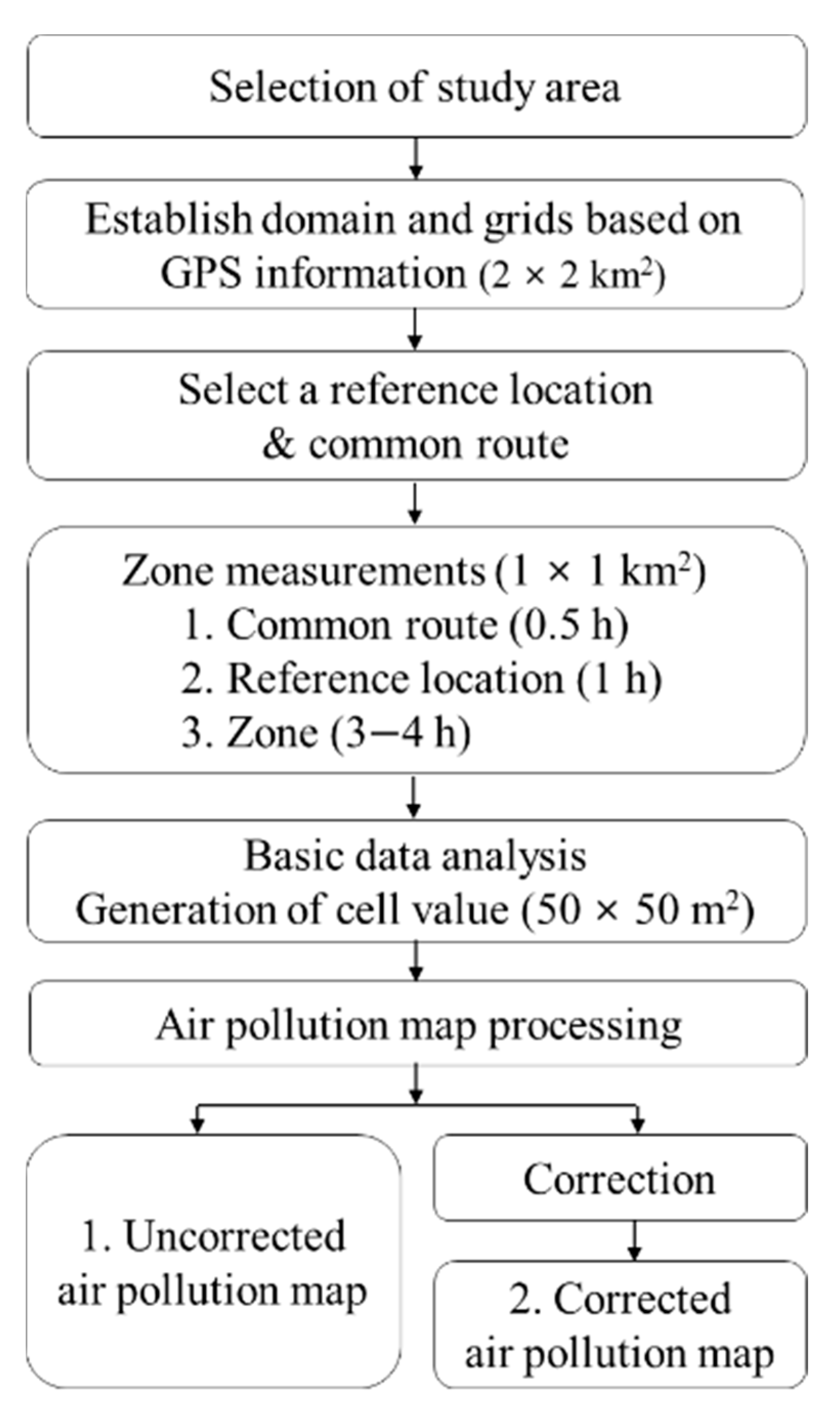
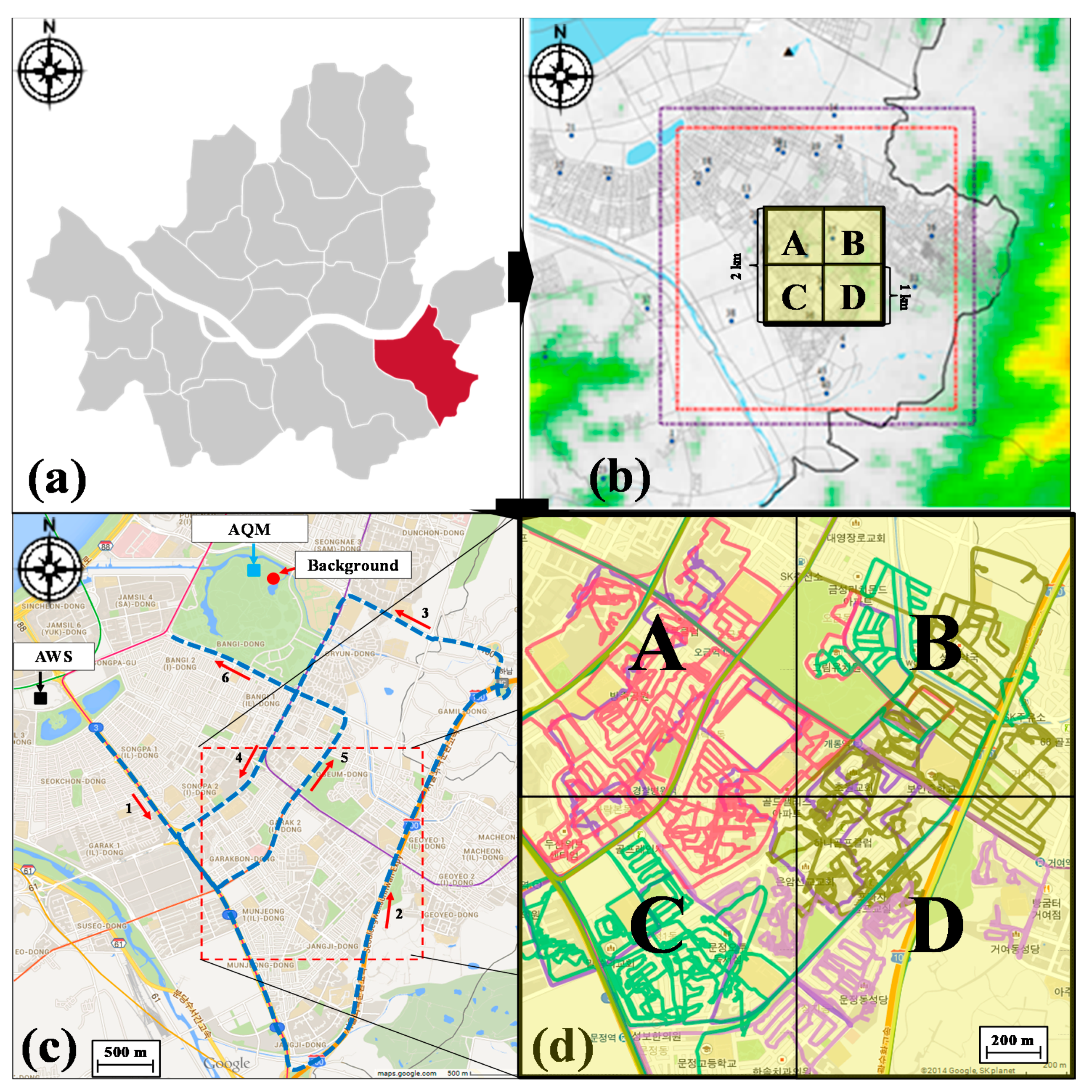
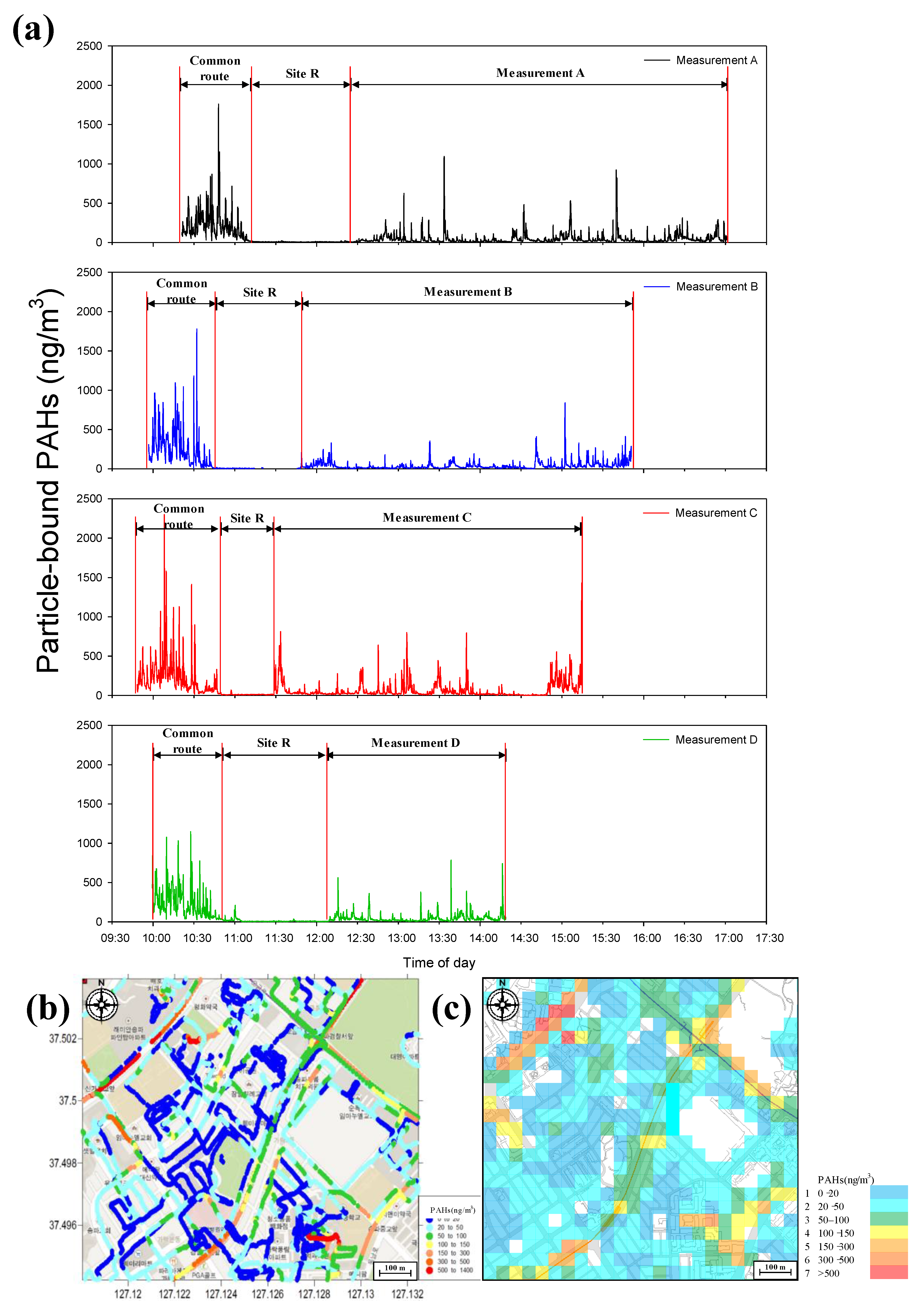
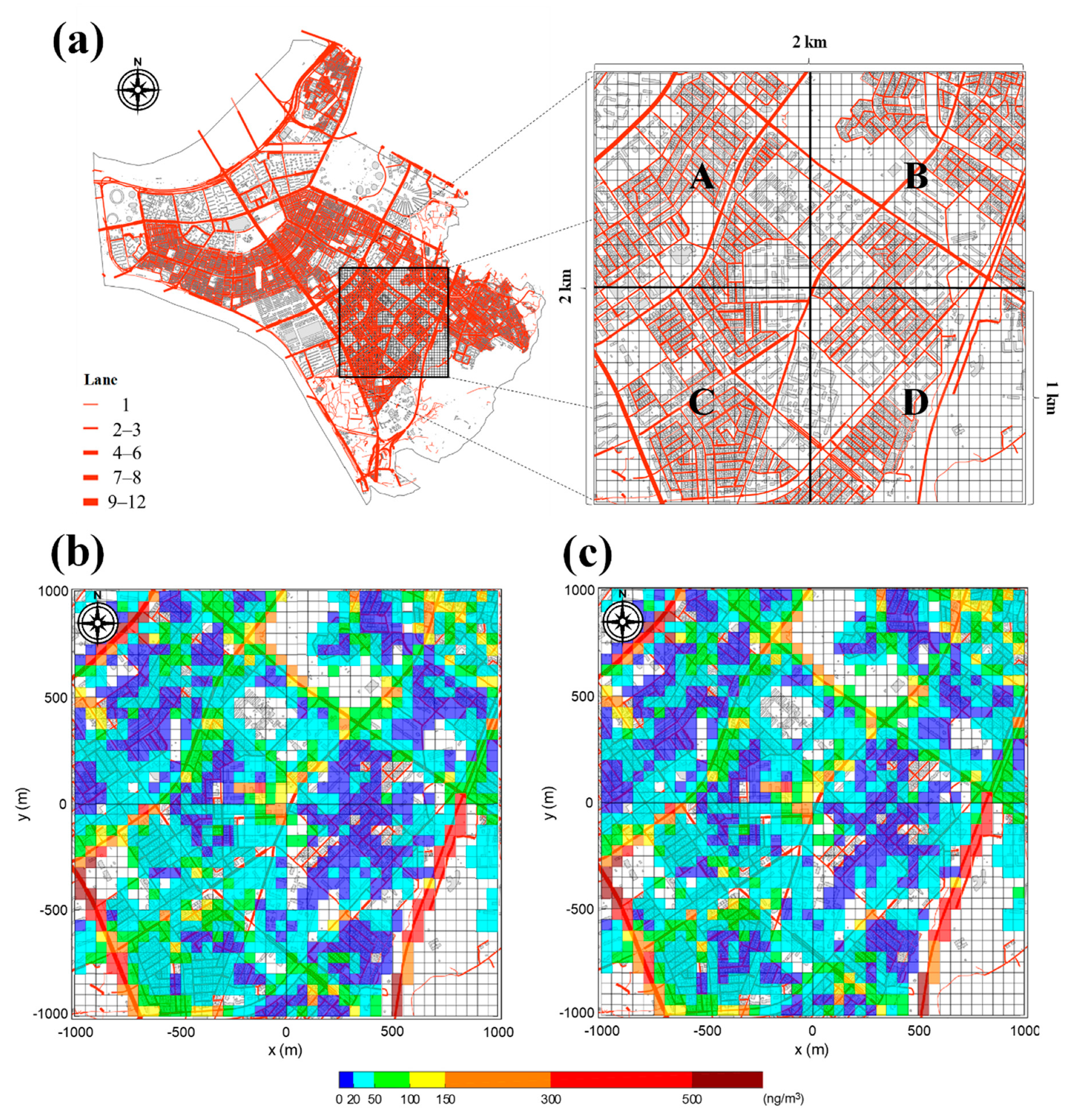
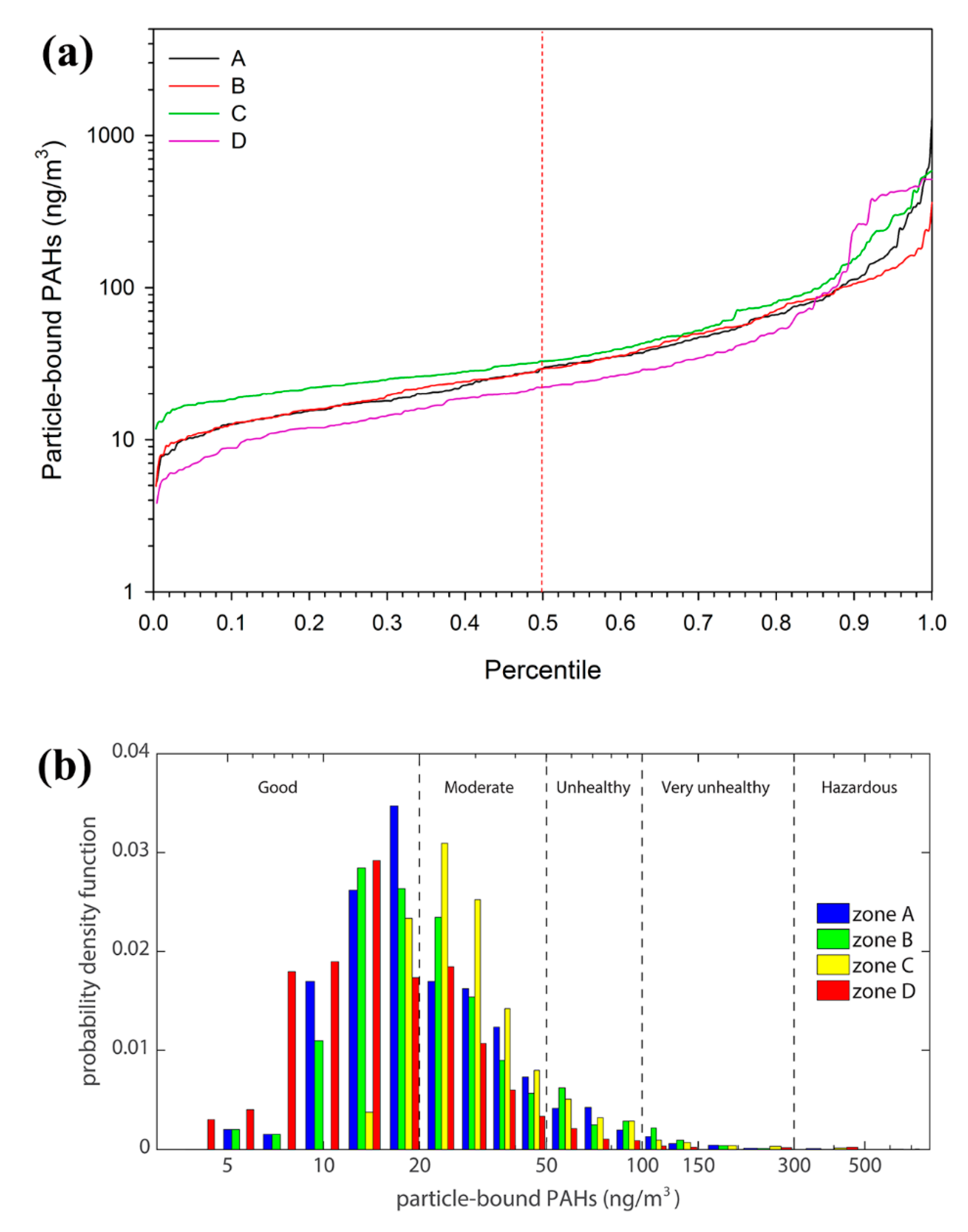
| Method | Regional-Scale Modeling | Local-Scale Modeling | Mobile Monitoring |
|---|---|---|---|
| Spatial resolution | 4 × 4 km2 | 200 × 200 m2 | 50 × 50 m2 |
| Number of air pollution data in a 4 × 4 km2 area | 1 | 400 | 6400 |
| Population per air pollution data * | 304,000 | 760 | 47.5 |
| Classification | Preliminary Measurement | Zone Measurements | |||
|---|---|---|---|---|---|
| (a) Reference location Measurement date and time | 11:30–12:26 9 June | 11:15–12:39 10 June | 10:43–11:47 11 June | 10:49–11:26 12 June | 11:07–12:06 13 June |
| Average ± standard deviation | 9.4 ± 5.8 | 9.7 ± 6.7 | 6.2 ± 4.7 | 11.2 ± 6.6 | 5.3 ± 2.1 |
| (b) Common route Measurement date and time | 13:02–13:23 9 June | 10:21–10:41 10 June | 09:56–10:16 11 June | 09:49–10:10 12 June | 10:00–10:22 13 June |
| Average ± standard deviation | 255.0 ± 220.5 | 245.3 ± 134.1 | 333.4 ± 195.5 | 315.6 ± 272.7 | 316.2 ± 164.3 |
| Classification | Zone A | Zone B | Zone C | Zone D | |
|---|---|---|---|---|---|
| Zone-based (1 × 1 km2) | Number of valid data (n) | 12,583 | 10,372 | 10,304 | 6419 |
| Average (ng/m3) | 57 ± 106 | 42 ± 43 | 70 ± 82 | 95 ± 159 | |
| Median (ng/m3) | 29 | 28 | 35 | 29 | |
| 5% (ng/m3) | 10 | 10 | 18 | 10 | |
| 25% (ng/m3) | 17 | 17 | 25 | 18 | |
| 75% (ng/m3) | 53 | 51 | 74 | 68 | |
| 95% (ng/m3) | 179 | 118 | 266 | 532 | |
| Cell-based (50 × 50 m2) | Number of valid data (n/km2) | 12,120 | 9906 | 8214 | 5903 |
| Number of valid cells (/km2) | 334 | 316 | 335 | 242 | |
| Average (ng/m3) | 58 ± 106 | 46 ± 45 | 69 ± 97 | 67 ± 121 | |
| Median (ng/m3) | 30 | 29 | 33 | 22 | |
| 5% (ng/m3) | 10 | 11 | 17 | 7 | |
| 25% (ng/m3) | 17 | 17 | 23 | 13 | |
| 75% (ng/m3) | 55 | 56 | 71 | 42 | |
| 95% (ng/m3) | 182 | 135 | 292 | 424 | |
| Meteorological variables | Wind speed (m/s) | 1.6 ± 0.6 | 2.4 ± 0.5 | 1.8 ± 0.4 | 2.1 ± 0.4 |
| Prevailing wind direction | NW, SE | NE | SE | NW | |
| Temperature (°C) | 27.2 ± 0.4 | 27.2 ± 1.9 | 23.9 ± 2.2 | 25.5 ± 0.9 | |
| Relative humidity (%) | 70.8 | 72 | 87.1 | 73.9 |
| Pollution Level | Zone A | Zone B | Zone C | Zone D |
|---|---|---|---|---|
| Good (pPAH ≤ 20 ng/m3) | 115/124 * (34.4/37.1%) | 98/84 (31.0/26.6%) | 49/59 (14.6/17.6%) | 110/86 (45.5/35.5%) |
| Moderate (20 < pPAH ≤ 50 ng/m3) | 127/119 (38.0/35.6%) | 125/133 (39.6/42.1%) | 180/175 (53.7/52.2%) | 82/102 (33.9/42.1%) |
| Unhealthy (50 < pPAH ≤ 100 ng/m3) | 52/51 (15.6/15.3%) | 56/61 (17.7/19.3%) | 57/52 (17.0/15.5%) | 19/22 (7.9/9.1%) |
| Very unhealthy (100 < pPAH ≤ 300 ng/m3) | 29/29 (8.7/8.7%) | 36/37 (11.4/11.7%) | 34/34 (10.1/10.1%) | 11/12 (4.5/5.0%) |
| Hazardous (pPAH > 300 ng/m3) | 11/11 (3.3/3.3%) | 1/1 (0.3/0.3%) | 15/15 (4.5/4.5%) | 20/20 (8.3/8.3%) |
© 2020 by the authors. Licensee MDPI, Basel, Switzerland. This article is an open access article distributed under the terms and conditions of the Creative Commons Attribution (CC BY) license (http://creativecommons.org/licenses/by/4.0/).
Share and Cite
Kim, K.H.; Kwak, K.-H.; Lee, J.Y.; Woo, S.H.; Kim, J.B.; Lee, S.-B.; Ryu, S.H.; Kim, C.H.; Bae, G.-N.; Oh, I. Spatial Mapping of a Highly Non-Uniform Distribution of Particle-Bound PAH in a Densely Populated Urban Area. Atmosphere 2020, 11, 496. https://doi.org/10.3390/atmos11050496
Kim KH, Kwak K-H, Lee JY, Woo SH, Kim JB, Lee S-B, Ryu SH, Kim CH, Bae G-N, Oh I. Spatial Mapping of a Highly Non-Uniform Distribution of Particle-Bound PAH in a Densely Populated Urban Area. Atmosphere. 2020; 11(5):496. https://doi.org/10.3390/atmos11050496
Chicago/Turabian StyleKim, Kyung Hwan, Kyung-Hwan Kwak, Jae Young Lee, Sung Ho Woo, Jong Bum Kim, Seung-Bok Lee, Sung Hee Ryu, Chang Hyeok Kim, Gwi-Nam Bae, and Inbo Oh. 2020. "Spatial Mapping of a Highly Non-Uniform Distribution of Particle-Bound PAH in a Densely Populated Urban Area" Atmosphere 11, no. 5: 496. https://doi.org/10.3390/atmos11050496
APA StyleKim, K. H., Kwak, K.-H., Lee, J. Y., Woo, S. H., Kim, J. B., Lee, S.-B., Ryu, S. H., Kim, C. H., Bae, G.-N., & Oh, I. (2020). Spatial Mapping of a Highly Non-Uniform Distribution of Particle-Bound PAH in a Densely Populated Urban Area. Atmosphere, 11(5), 496. https://doi.org/10.3390/atmos11050496







